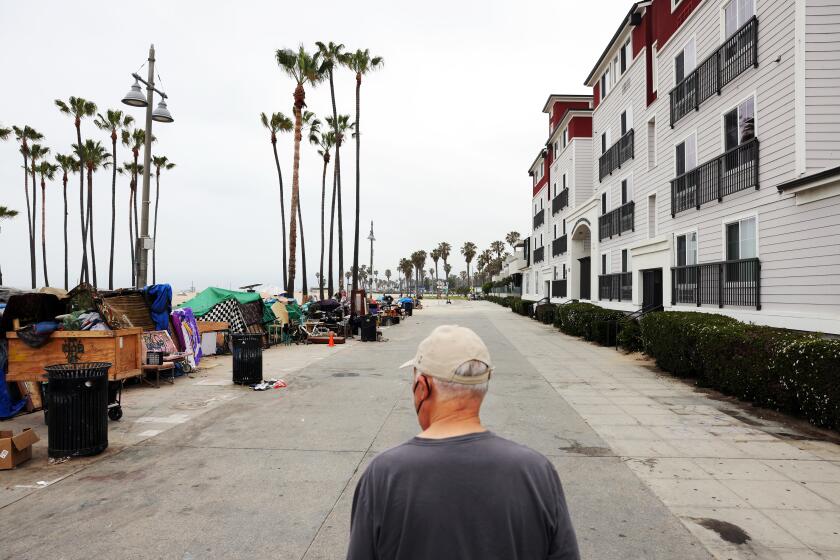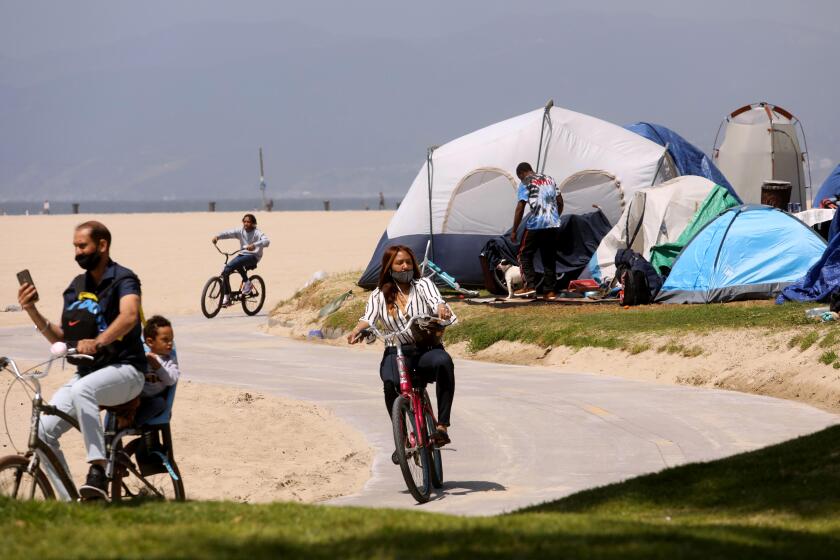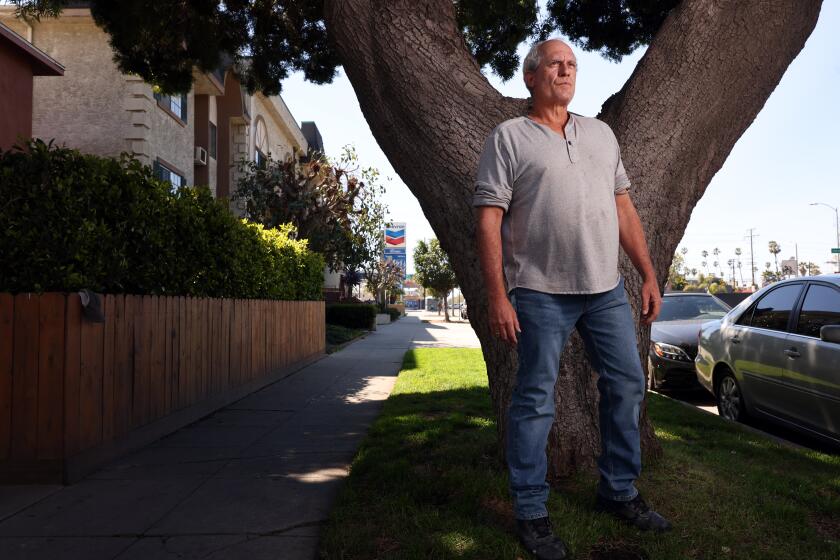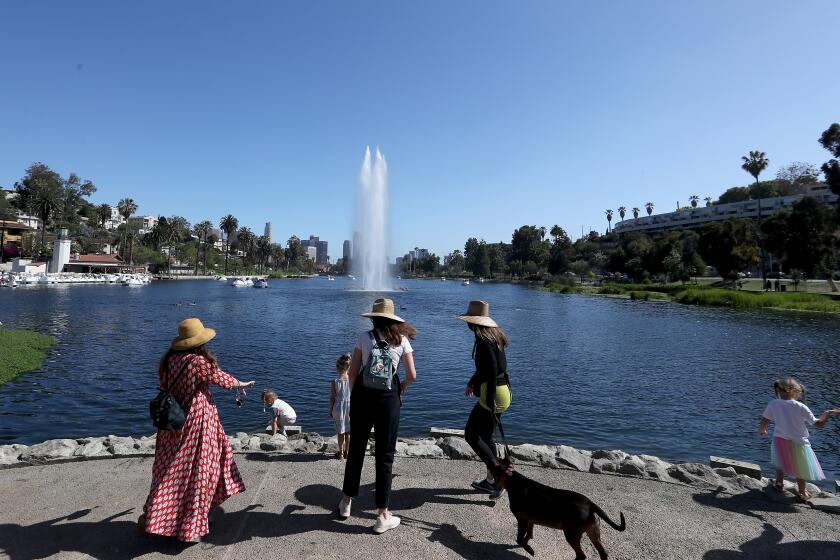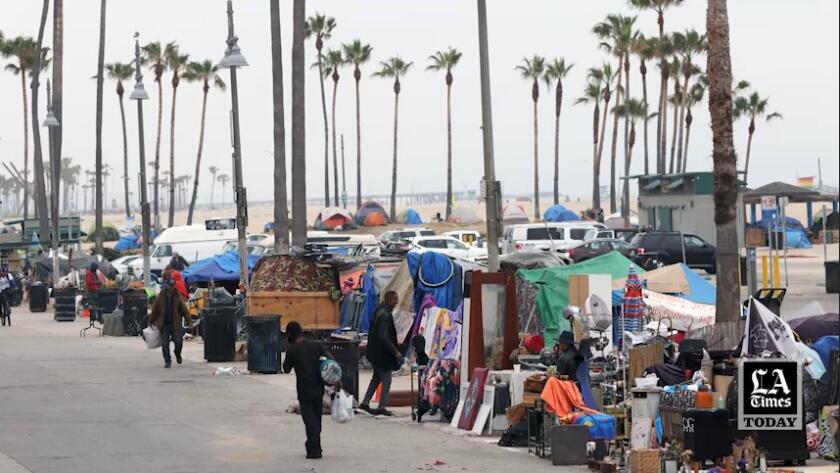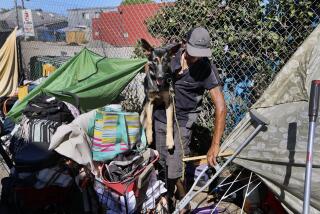
- Share via
Venice Beach has long been L.A.‘s haven for the offbeat and out-of-step, a magnet for throngs of the curious drawn by the precarious balance between natural beauty and human eccentricity.
But recently, that magical Venice has become a caricature of itself. Shamed almost daily in eyewitness videos of trash, mayhem and fire, its milelong ribbon of tents and shanties is now held up as the hallmark of everything broken about Los Angeles.
“The beatings, the murders of senior citizens, the fires, the victimization of housed and unhoused, the black RV terrorizing families in a school zone, the unanswered emails, unreturned phone calls; there is no excuse for your absence and neglect,” one resident wrote as part of what has become a daily barrage of screaming emails directed at city leaders.
But could Venice, a quintessential beach community that is one of California’s most popular tourist destinations, rise again? There’s a plan for that, emerging from behind-the-scenes talks among a coalition of Venice activists, city officials and deputies of the area’s city councilman, Mike Bonin.
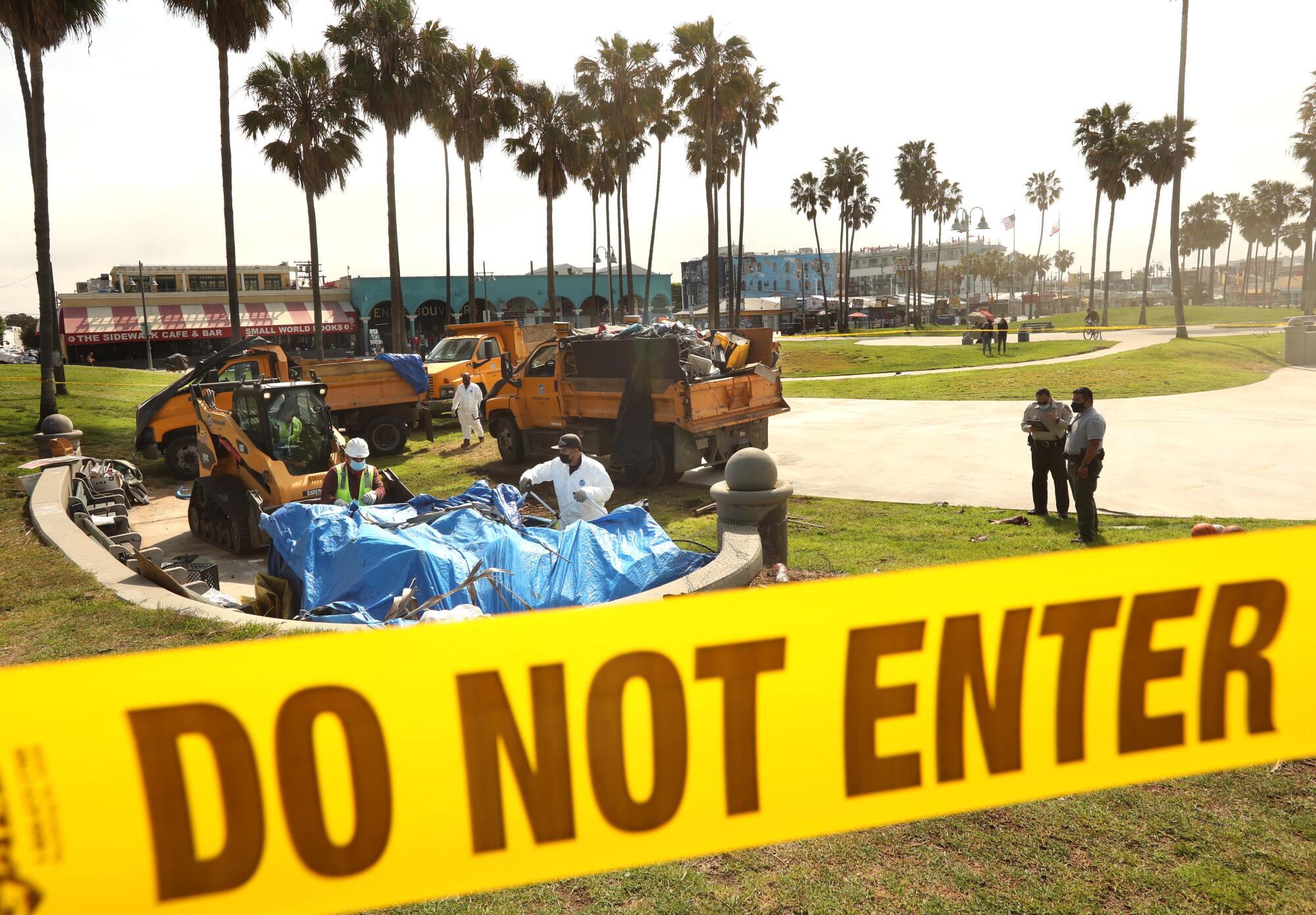
In an extensive interview with The Times, Bonin disclosed outlines of his plan to clear the illegal encampments in what he characterized as a more orderly and humane replay of the closure of Echo Park Lake in March. A coordinated push by homeless services providers and city crews will clear the homeless camps in small zones, Bonin said, using robust outreach, offers of shelter or housing, and lots of persuasion.
Bonin, who is under withering criticism from Venice residents who blame his inaction for the neighborhood’s condition, said he finds camping on the public land unacceptable and promised to end it. But he would not commit to a deadline until he’s confident the resources are available to meet it.
Bonin has since gotten into a tug-of-war over methods with Los Angeles County Sheriff Alex Villanueva, who sent foot patrols to the boardwalk on Monday and said the tents should be cleared by July 4.
“Even if I were predisposed to do this Echo Park Lake-style, it’s really hard to do it in Venice Beach,” Bonin said in the interview, and vowed that enforcement, if necessary as a last resort, would not be the heavy-handed policing that accompanied the closing of Echo Park Lake.
“It’s freaking huge. I think it would be logistically impossible to close off the entire thing as was done for a couple months at Echo Park.”
The plan largely reflects a blueprint a group of community activists has been pressing on the 11th District councilman in private talks over the past several weeks.
Community proposal to clean up Venice Boardwalk.
Those activists, a collection of unlikely allies who say they are seeking the middle ground in an emotionally wrought and divided community, have all criticized Bonin for allowing the homeless camps to grow uncontrollably.
They say they are encouraged by his promise to do something but remain skeptical that he will follow through.
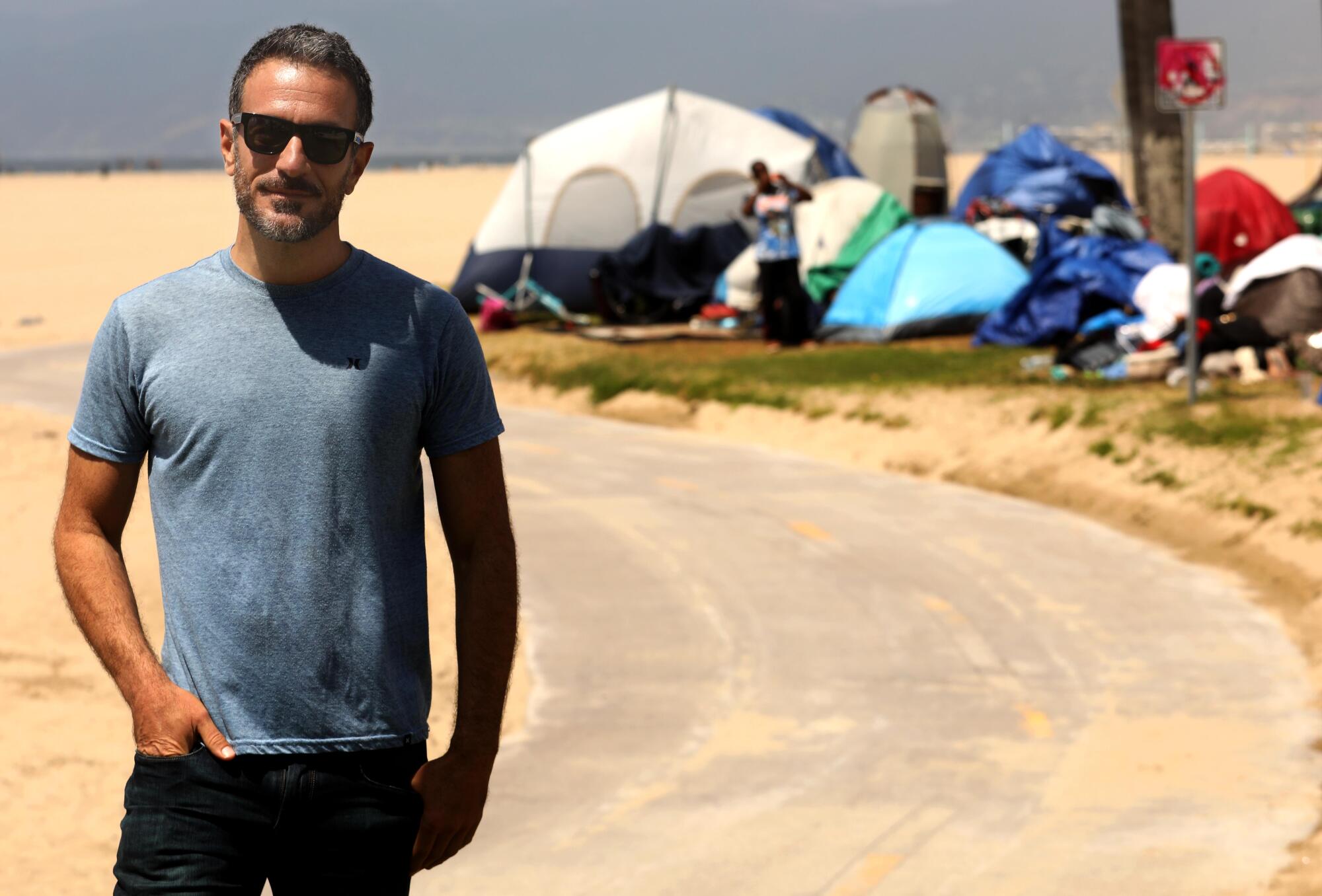
“I’m really pressing for a deadline,” said Brian Averill, founder of a group he calls the Venice Boardwalk Action Committee. “If you don’t have some sort of ticking clock to share with the people out there, they are not going to take it seriously.”
Averill, a surfer and freelance photographer who rents in the storied Ellison building, has joined two other grassroots groups, one founded by a speechwriter and the other a martial artist, in a coalition they call Venice Clean and Safe for the Summer.
“The idea is to hold the city, specifically CD11, accountable to making some progress on this proposal,” Averill said.
In January, Averill’s group proposed breaking what seems an insurmountable problem into pieces. A document he submitted to the city suggests starting at the north end of the boardwalk, where the tents are most condensed, then moving south in phases until the boardwalk is clear.
Something like that strategy got underway in May, in a less ambitious manner than Averill and his allies had in mind. The city‘s Department of Recreation and Parks, in response to the loosening of pandemic guidelines, ended restrictions on recreational use of four handball courts adjacent to the boardwalk. The three-walled enclosures were full of tents and about a dozen people.
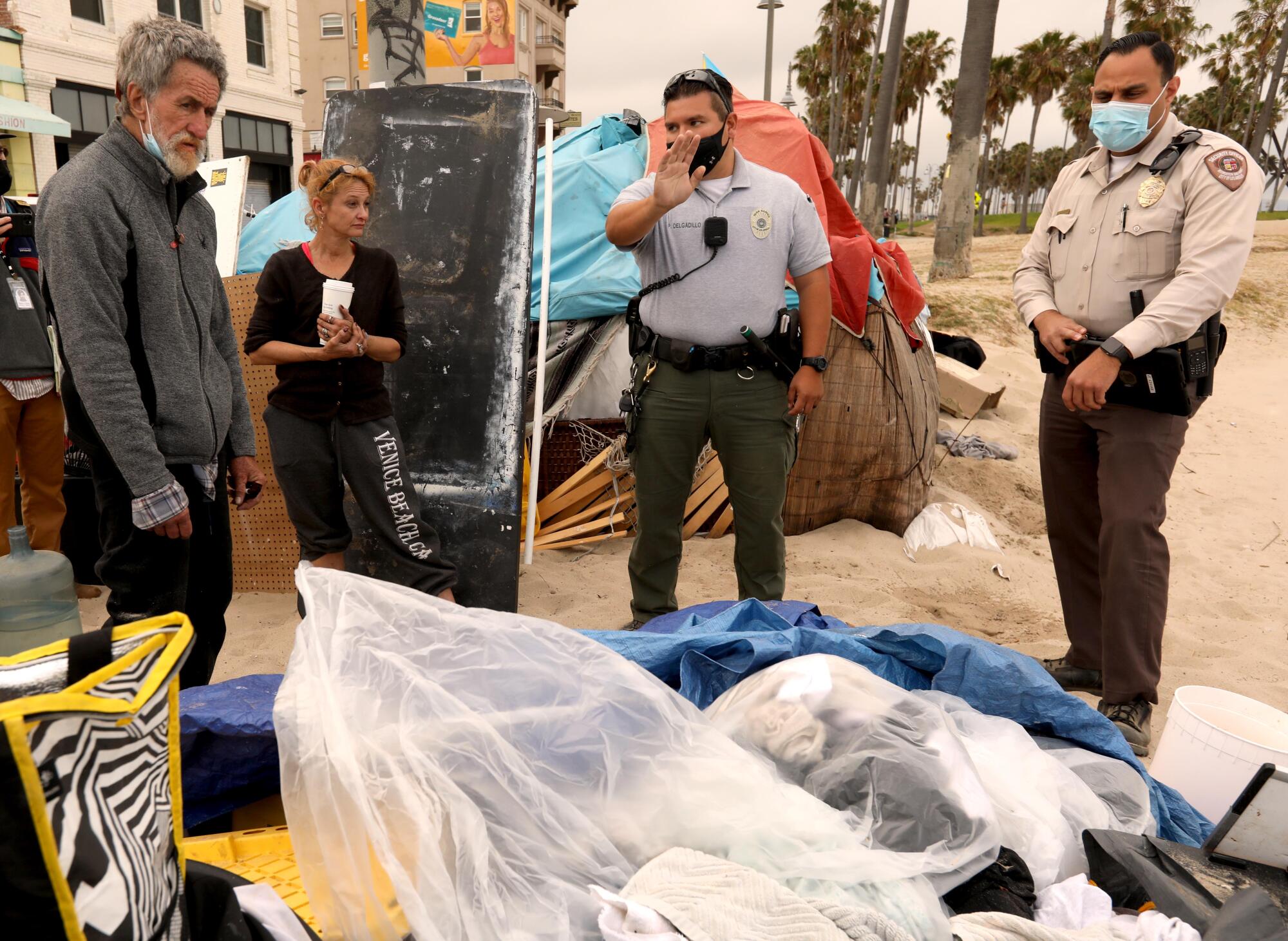
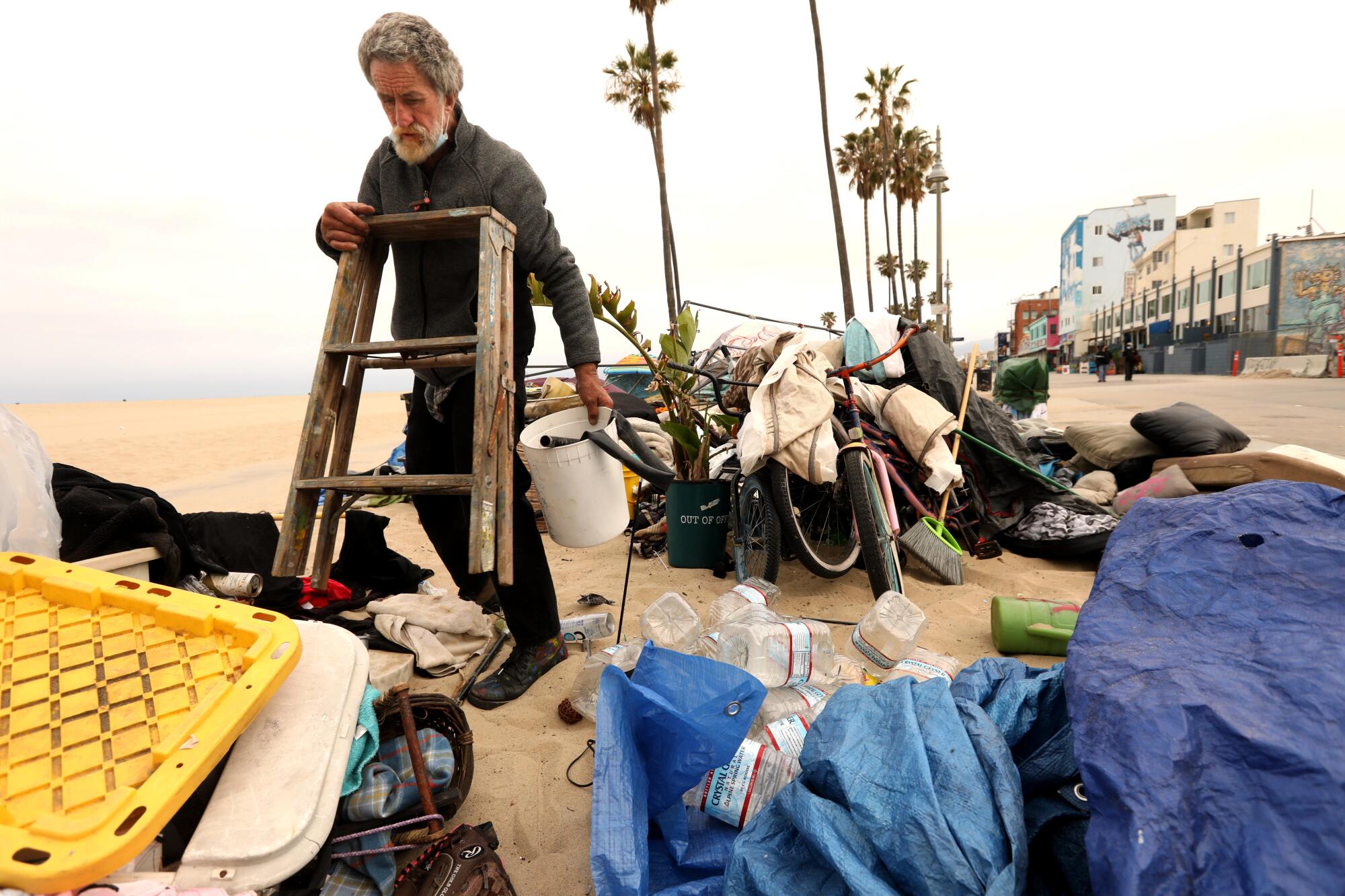
The people agreed to move to shelters, and crews moved in on May 18, taking away tents, furnishings and detritus in dump trucks. Two weeks later, the crews were back with another incremental step: clearing tents and possessions from the spaces on the boardwalk marked for vendors to set up their wares, and from certain areas in the park along the beach bike path.
The two cleanups left largely intact more than 200 tents and homemade structures strung along a narrow earthen berm that separates the concrete boardwalk from the bicycle path and beach beyond.
The trauma and discord that may lie ahead were on display when workers removed a small camp that had encroached on the Roller Skate Dance Plaza at the north end of the recreation area.
As a gallery of cellphones and cameras zoomed in, a man whose tent and possessions had just been swallowed by a mechanical loader waved his arms and yelled at the scrum of videographers, “I hate you all.”
Then he pulled down his pants with nothing on underneath.
His was far from the only angst in the air.
A woman filming on behalf of a pro-homeless group called the Venice Justice Committee lashed out at a beefy, long-haired man who was recording for his YouTube channel, “German in Venice.” She called him “a hater” exploiting the homeless man’s pain for profit. His video of the event has drawn 300,000 views so far.
In recent years, the boardwalk has become an open-air clinic for poor residents, people struggling with addiction and those in physical or mental distress.
Before this confrontation, Recreation and Parks rangers told people where they could keep their possessions, and that at some point they wouldn’t be able to stay by the boardwalk anymore.
While that was getting underway, Kenneth Stallworth, 62, sat outside his tent on the beach, taking in the morning breeze. Stallworth has been homeless for eight years and said struggles with gambling left him with little money. He’s been receiving general relief, but it’s not enough to afford rent or permanent place to stay.
He has had a placement in a nearby shelter but rarely stays the night. He prefers a tent by the beach.
“The police, they give me tickets all the time. What they really want to do is intimidate,“ he said.
Stallworth walked off to run some errands and begin his day. Minutes after he left, a crew from the Department of Recreation and Parks picked up his tent and the couch he’d been using as a bed and placed them on a flatbed truck heading for the dump.
Built on a drained marsh in 1905, the Venice of developer Abbot Kinney was a quirky tourist attraction with canals, a main street of faux Venetian buildings and an amusement pier. Consolidation with Los Angeles and an oil drilling boom in the 1920s gave way to an era of neglect that rendered Venice into that Southern California rarity, a seaside community affordable to those of modest income, including intellectuals and beach bums who renounced capitalistic life.
L.A. City Councilman Mike Bonin lays out his vision of how a humane clearing of tents that run along the Venice boardwalk could occur.
Venice today is a fractured mixture of that celebrated bohemian culture, with its inherent attraction to beach lovers and itinerant youth and a more recent contingent of highly paid tech workers and well-heeled homeowners.
Much of it is concentrated west of Highway 1, where clapboard surfer shacks, aging brick apartment buildings and tourist shops redolent of ‘60s counterculture coexist with trendy restaurants, multimillion-dollar designer houses and the offices of tech giants.
As many as 2,000 people sleeping in tents, tarpaulin shacks, recreational vehicles and sometimes residents’ front yards — a concentration of homeless people second only to skid row — make Venice a place of intimate daily contact between those of means and society’s dispossessed.
Drawn by Venice’s mystique and reputation for tolerance, the homeless people there transcend simple categories. More than anywhere else in Los Angeles, most are outsiders, having migrated from other parts of the city and other states around the U.S.
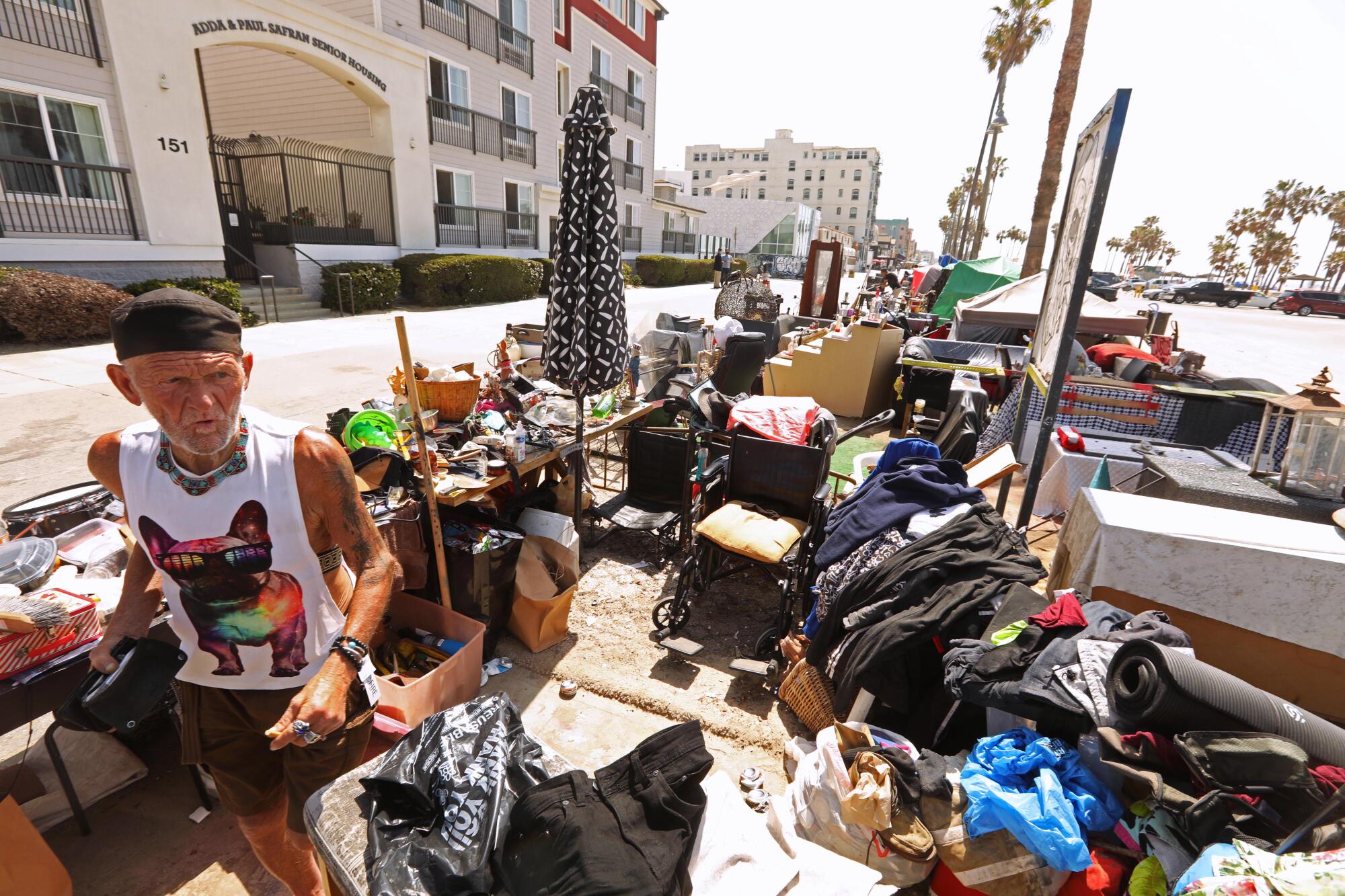
At the north end, where the Santa Monica border brings an abrupt end to camping, Kenny Abby, originally from the Midwest, sat bare-chested in a lawn chair, bronzed and contented amid an outdoor closet of apparel and found items.
“It’s lovely,” Abby said of his prime spot. “Since COVID, it’s been easier to stay here than ever before.”
A few spaces to the south, a woman who would not give her name displayed her herbs and succulents on a stout structure of green two-by-fours. Farther still, a free-spirited woman who gave her name as Miriam Rabbeinu had surrounded her tent with a gallery of her feminist-themed artwork.
Interspersed with several other artists were musicians, playing for money or just playing. A tougher-looking crowd held forth at the picnic tables with boom boxes blaring and looks that said, “Don’t ask.”
Moving through the scene were the spaced-out and the shouters, airing grievances real or imagined.
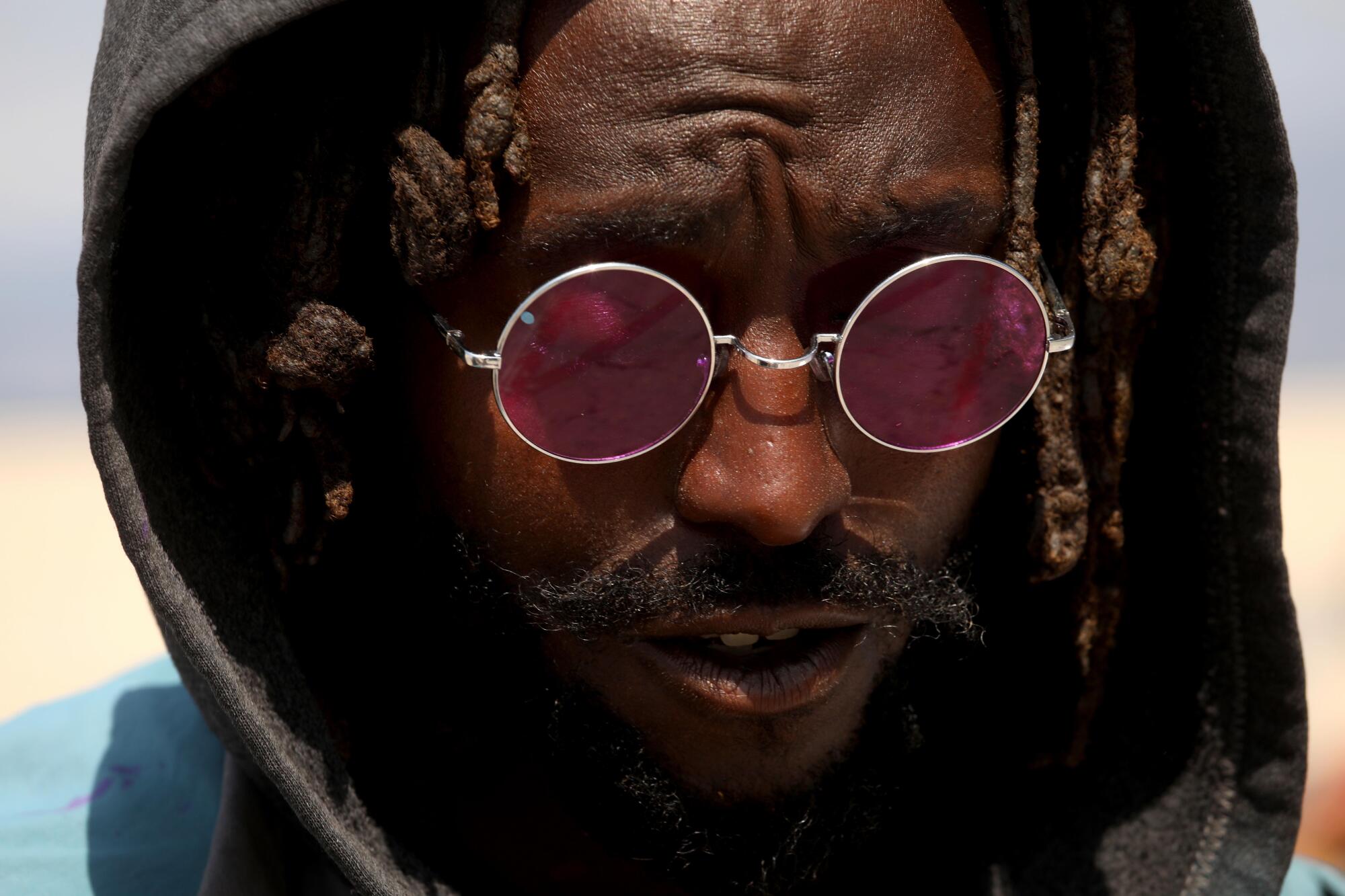
Along the boardwalk, Vernon English — who came from Chicago in 2017 — sold his art, effusive swatches of color evoking Mark Rothko. He’d built sets in the Midwest but knew he wanted to do something more creative.
So he came to Venice. At night, he covers his art with a tarp and beds down in the alleys — making sure to avoid the larger encampments, which he said tend to be full of trouble. He pays for art supplies by helping shop owners along the boardwalk clean up and hopes to afford a rental apartment.
At the moment, that proposition is daunting.
“This is the best office space ever,” he said. “Still, I want to save up six months’ rent. That’s a ton of money.”
In Venice, residents worry that a homeless man jailed after allegedly attacking and terrorizing neighbors may soon be back on the streets.
Homelessness in Venice has been a much debated —and litigated — subject. In the late 1980s, more than a thousand locals signed a petition complaining about hundreds of tents on the beach.
Decades later, activists sued in 2015 to strike down the City of Los Angeles’ overnight beach curfew, which they say was only enforced to drive out homeless people.
Lisa Redmond, a homelessness activist with the Venice Catholic Worker, is helping provide outreach and services on the boardwalk and says it’s no surprise people flock there. Aside from its inviting ocean view, there are nearby toilets and running water — necessities that are hard to find when one is homeless.
Although she thinks Bonin’s plan is the most humane option on the table, the whole endeavor, which she sees as being driven by pressure from nearby homeowners and business owners, leaves her frustrated.
“I think Bonin is caving into the whims of the people that want the beach cleared,” she said.
There’s no definitive cause or starting point for the increase in homeless people, but it’s generally agreed that the city’s suspension of homeless cleanups during the pandemic has contributed to its rapid spread.
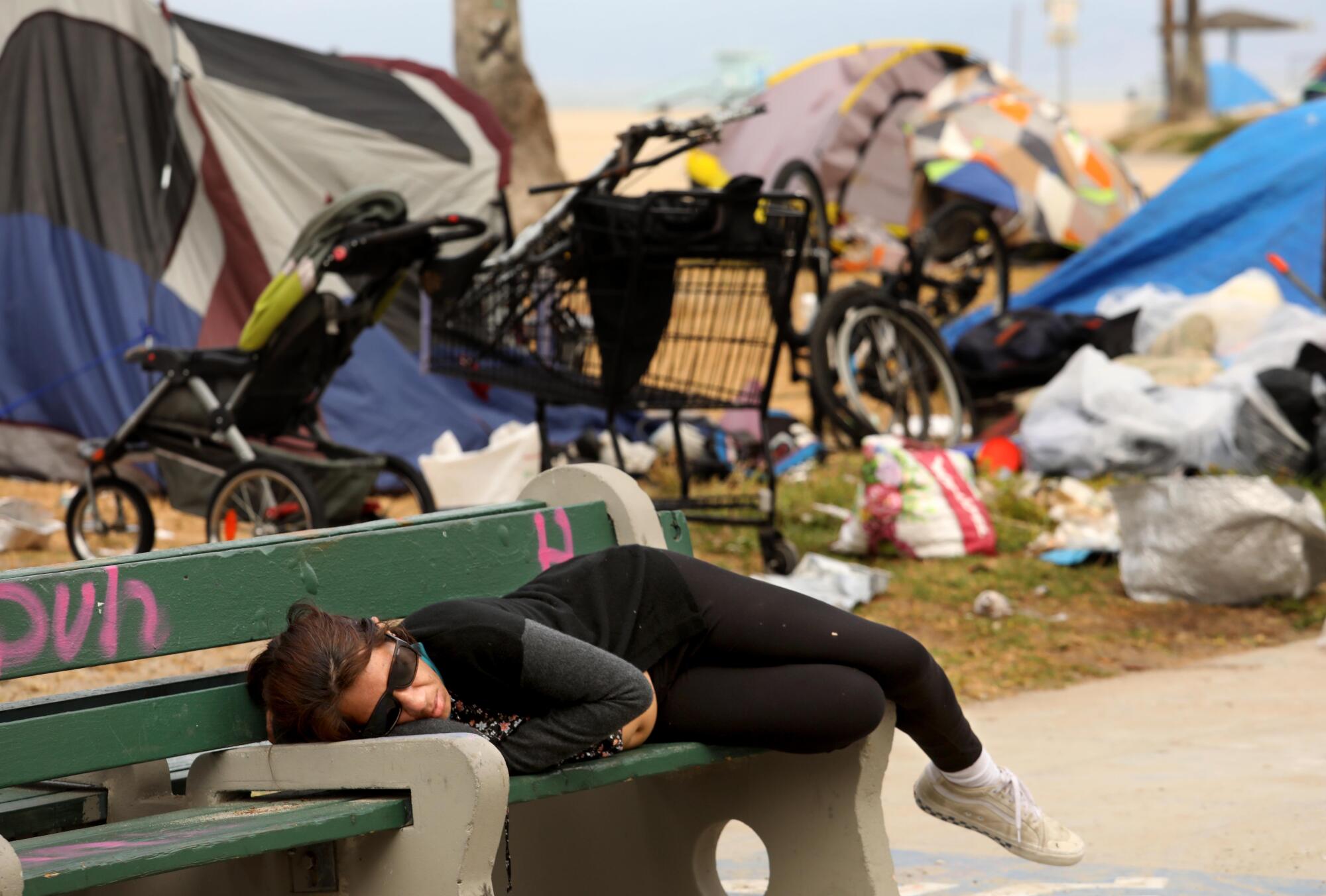
A pivotal event was the placement of one of Mayor Eric Garcetti’s A Bridge Home shelters on a former MTA bus storage lot a few blocks inland where trendy Abbot Kinney Boulevard meets Main Street.
Trying vainly to mollify hostile opposition, Garcetti and Bonin promised extra police patrols and sanitation to keep the streets around the new shelter free of camps.
Just the opposite happened. Only days after the March 2020 opening, the city suspended homeless camp cleanups in accordance with its interpretation of Centers for Disease Control and Prevention guidelines, and the shelter cut its capacity in half.
An expanse of tents quickly bloomed where there had been only a scattering. Third and Hampton streets, with two of Venice’s most popular restaurants at either end, were rendered into homeless alleys, with tents and rickety structures covering sidewalks on both sides of the street. Around the corner, on Sunset Avenue, tents have taken over the sidewalk in front of a modernistic apartment building. More tents, and the black RV that neighbors say is terrorizing them, appeared farther south around a dog park and Westminster Elementary.
Subscribers get early access to this story
We’re offering L.A. Times subscribers first access to our best journalism. Thank you for your support.
Given license by a freeze on ticketing, recreational vehicles in various states of disrepair filled the two-block commercial portion of Main Street in front of the gigantic binocular facade of the building now occupied by Google.
How much the coronavirus is at fault is debated.
Venice homeowner and activist Mark Ryavec, who was trounced in a 2017 attempt to unset Bonin, blames the councilman for misinterpreting the CDC guidelines, which urged localities not to disrupt homeless camps.
“CDC guidelines did not say, ‘Go live at the beach,’” Ryavec said. “The CDC guidelines say, ‘Stay where you are.’”
Whatever the cause, the effect was dramatic.
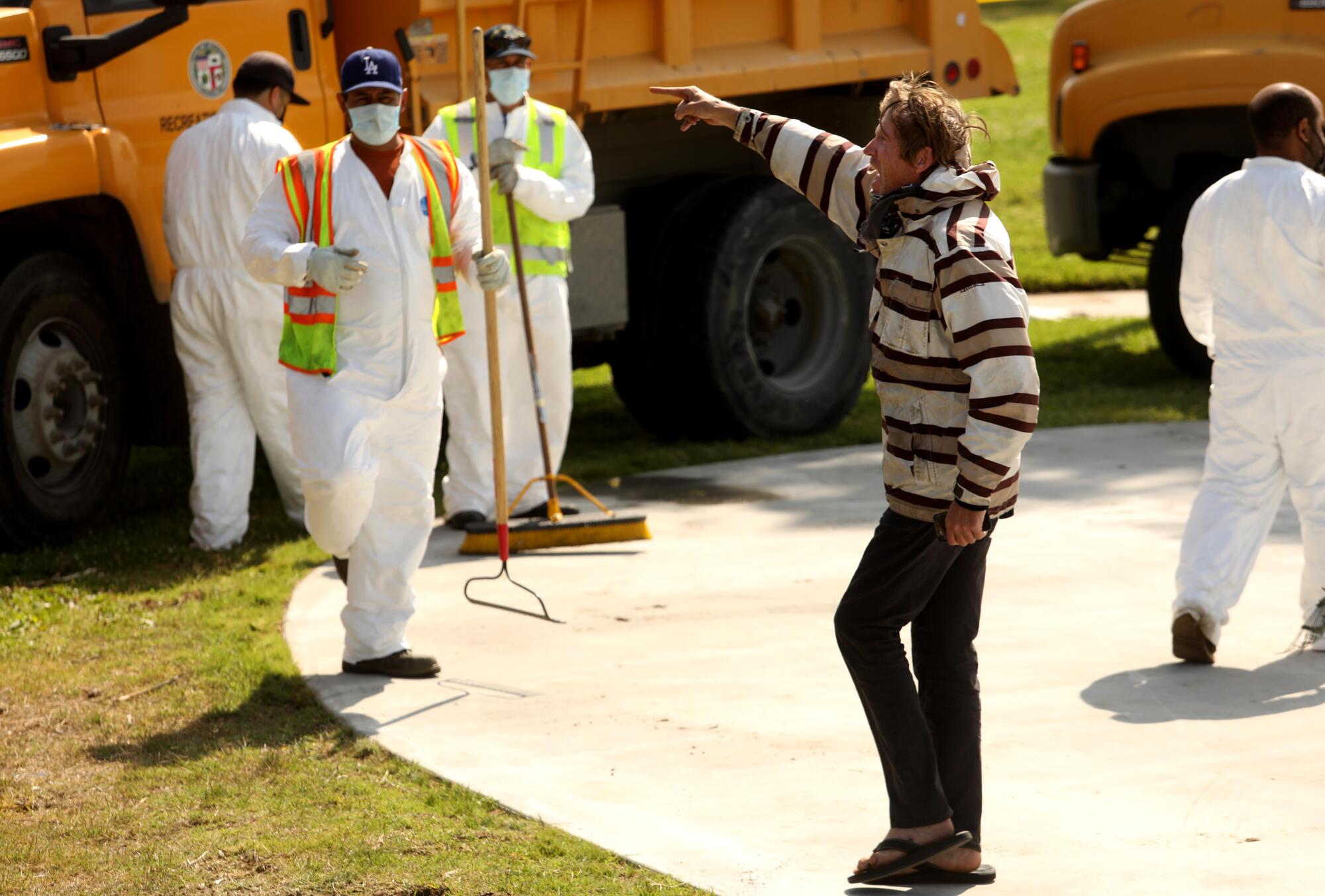
A crime spike forewarned by shelter opponents became a reality. A Times analysis of LAPD crime data for the Venice Beach area showed that in 2020, assaults, robberies and trespassing were all up more than 50% over the prior year. Burglaries climbed 15%.
The Los Angeles County Coroner recorded 19 deaths of homeless people in Venice during 2020. Eight were due to drug overdoses and three were ruled homicides, two by gunshot and one by blunt trauma.
The Los Angeles Police Department has reported even sharper crime increases this year.
In the first week of June, a security guard on Washington Boulevard was severely wounded by a homeless man wielding a shattered bottle, and an elderly man singing on the boardwalk was punched to the ground in an apparently random attack.
On Monday, a woman with a knife near Los Angeles City Councilman Joe Buscaino was arrested after he made a campaign appearance on the boardwalk. That occurred shortly before Villanueva was spotted on the boardwalk, criticizing elected officials for their response to homelessness and vowing to do more. Sheriff’s deputies began what they said will be regular patrols Monday.
Los Angeles County Sheriff Alex Villanueva waded into the morass of homelessness in Los Angeles this week by deploying deputies to the Venice boardwalk, a tinderbox in the city’s struggle to deal with the mounting crisis.
Residents have begun recording videos showing fights outside their homes, syringes and human waste, mentally unstable people in their yards, and fires that break out regularly. Several of the videos have been turned into slickly produced montages portraying Venice in the throes of mayhem.
Like many of her neighbors, Soledad Ursua, who owns a vintage wood house between the shelter and the dog park, installed a surveillance system and built a fence with an electronic keypad — the latest architectural trend in Venice — to enclose her tiny front yard.
“We have a major drug problem on our hands, and it is being disguised as housing crisis,” Ursua wrote to Garcetti in June 2019 when the shelter was under construction. “I am not able to sleep through the night anymore. There is always a group of people doing drugs outside my home.”
Ursua, a member of the Venice Neighborhood Council, has led its activist health and safety committee in pressing Bonin to follow the example of Councilman Mitch O’Farrell, who had Echo Park Lake fenced off this year after removing a large homeless camp. Because the boardwalk is a city park, it could be cleared under the same municipal ordinance that underpinned the evacuation of the lake, they say.
A spruced-up Echo Park Lake reopened Tuesday, exactly two months since it was closed in the wake of a police crackdown on a large homeless encampment.
Bonin has criticized O’Farrell over the last-minute turmoil that tarnished that operation as more than 100 stragglers were hastily evacuated under threat of imminent eviction. Then police swooped in to roughly squelch a show of civil disobedience by homeless rights advocates.
Instead, he said, he believes that a large-scale push of outreach by service providers can achieve the same result without the heavy-handed tactics.
He can point to a precedent. Last fall, Bonin called on St. Joseph Center, the nonprofit social services agency a few blocks away, to concentrate outreach on a string of tents on a strip of land beside the city-owned Penmar Golf Course.
Over about a month, Chief Executive Val Lecia Adams Kellum said, St. Joseph identified 77 people in the camp and was able to move 70 into six motels, including two run by Project Roomkey, a statewide program that converts hotels and motels into temporary housing. It was done with minimal police support.
Bonin said he now plans to repeat that on a larger scale. The effort began Monday when St. Joseph outreach workers began what has been dubbed Homeless Connect Days, sitting at “triage” tables to identify those living on the boardwalk who want to move indoors. Bonin said L.A. County Supervisor Sheila Kuehl, whose district also encompasses Venice, is committing space in detox and mental health facilities for those who need them.
At some point, Bonin said, a small area will be cleared as housing becomes available, and gradually that area will be expanded to the entire boardwalk. Living space for more than 100 people will become available in the coming weeks, he said, including a Ramada Inn with 35 rooms and 63 beds in shared housing.
That is fewer than the 167 people estimated by St. Joseph to be living on the boardwalk. Bonin was adamant that no one would be required to leave without an offer of housing.
Bonin’s most strident critics don’t believe he means it. They have launched a recall petition, whose supporters accuse the councilman of tolerating the camps because of “knee-jerk support for the homeless” while using the pandemic as a pretext.
“My belief is that until Bonin leaves office, Venice Beach will remain overrun by homeless encampments, drug sales and use, and crime (and fires),” Ryavec wrote on his Venice Stakeholders Assn. website.
Members of the Venice Clean and Safe for the Summer group say they are working with Bonin to see the plan through.
“I think the last stall they have is, ‘We’re trying to get housing for everybody,’” said Alex Stowell, a former owner of a boxing gym and 19-year renter on the boardwalk who now runs a photo business called Venice Paparazzi.
Stowell is the founder of Team Venice, a coalition of Venice Beach sports leagues that pressed the city for the handball court cleanup. He has joined with Averill and two longtime Venice property owners, Connie Brooks and Cari Devine Bjelajac, who formed a group called Friends of the Venice Boardwalk.
They have been meeting regularly since May with representatives of the LAPD, the Department of Recreation and Parks, St. Joseph Center, and Kuehl’s and Bonin’s offices. They supported the triage table as a first step but insisted on being involved to make sure it obtains the information they think is needed.
“You need to know who is out there,” Stowell said. “Names, how many people and what they want. Who wants to live outside?”
Faulting the service providers for not already having that information, they have begun doing their own outreach work, walking the boardwalk and listening to stories. That’s how they learned that Rabbeinu, the artist, had been arrested. She has not returned.
In a recent foray, homeowners Brooks and Bjelajac caught up with Stephen Smith, whose tent sat among half a dozen others atop a knoll that curls away from the boardwalk.
After chatting about his plan to go off the grid in Northern California, Smith, a 65-year-old who lost a family business under a crush of health problems, recounted witnessing a gang rape late one night. Then he pointed out the victim, a young woman who was walking in aimless circles talking to herself.
It had traumatized him, he said, because he was helpless to stop the attack by a group of gang members.
As they spoke, a man who had been yelling profanities at his partner inside a tent followed her onto the boardwalk and smacked her with a jacket before walking off.
The next day, Brooks reported, the same man assaulted a jogger. Anyone who frequents the boardwalk has seen it before.
“Anybody can see there’s a recipe for real disaster out there,” Stowell said. “As that becomes the undeniable reality, they’re going to have to make a move or face a bad future.”
- Share via
Watch L.A. Times Today at 7 p.m. on Spectrum News 1 on Channel 1 or live stream on the Spectrum News App. Palos Verdes Peninsula and Orange County viewers can watch on Cox Systems on channel 99.
More to Read
Sign up for Essential California
The most important California stories and recommendations in your inbox every morning.
You may occasionally receive promotional content from the Los Angeles Times.
